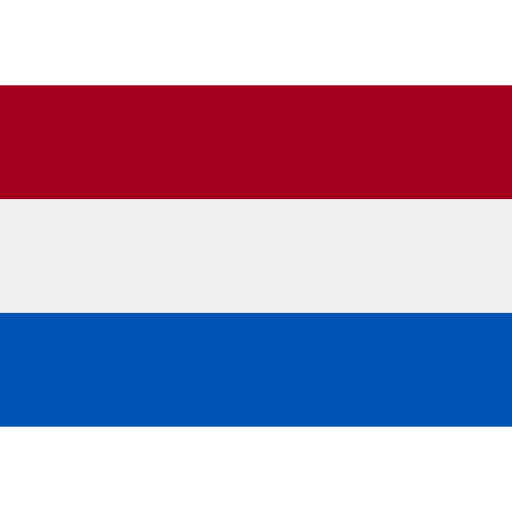Last Updated: 8 October 2025
How to Play Pot-Limit Omaha: PLO Rules, Hand Ranks & Odds
Learn how to play Pot-Limit Omaha, with a step-by-step walkthrough, rules, hand rankings, and basic PLO strategy. Master the basics, improve every day, and become the next PLO superstar.
Guides
What is Pot-Limit Omaha (PLO)?
The game of Pot Limit Omaha (PLO) was first introduced to Las Vegas casinos by Robert Turner in 1982. It’s similar to Texas Hold’em poker in many ways, with some major differences. Players are dealt four hole cards instead of two, the pot size limits betting, and two hole cards must be used to make a poker hand.
PLO became very popular in Europe in the early 2000s and eventually entered the online poker world as well. Its faster pace and higher variance make PLO the preferred choice of players who enjoy action, bigger pots, and closer preflop equities.
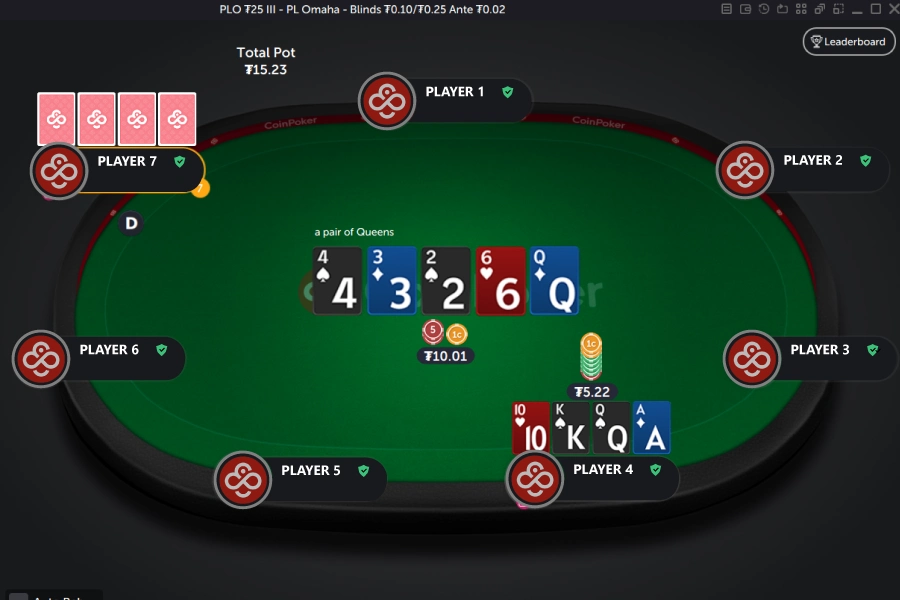
Rules of Pot-Limit Omaha: Everything You Need to Know
Pot Limit Omaha rules are more complex than Texas Hold’em’s, but the game still draws many basic rules from the “Cadillac of Poker.” Much like Texas Hold’em, the game is played with four betting rounds and five community cards.
Here are the key Pot Limit Omaha rules you need to know:
- # of Cards: Each player is dealt four hole cards
- Betting Rounds: Bets occur across four betting rounds (preflop, flop, turn, river)
- Shared Cards: A total of five community cards are dealt
- Making Combinations: Two hole cards and three community cards must be used at showdown
- Bet Sizes: Players can only bet or raise to the size of the pot
- Winning: The winner is determined according to the standardized poker hand rankings
How Pot-Limit Betting Works in PLO
Pot Limit in Omaha poker means you can only bet a maximum size. In a sense, this keeps things simple, but calculating the pot size isn’t always easy.
The pot size is always equal to money already in the pot, plus three times any outstanding bet.
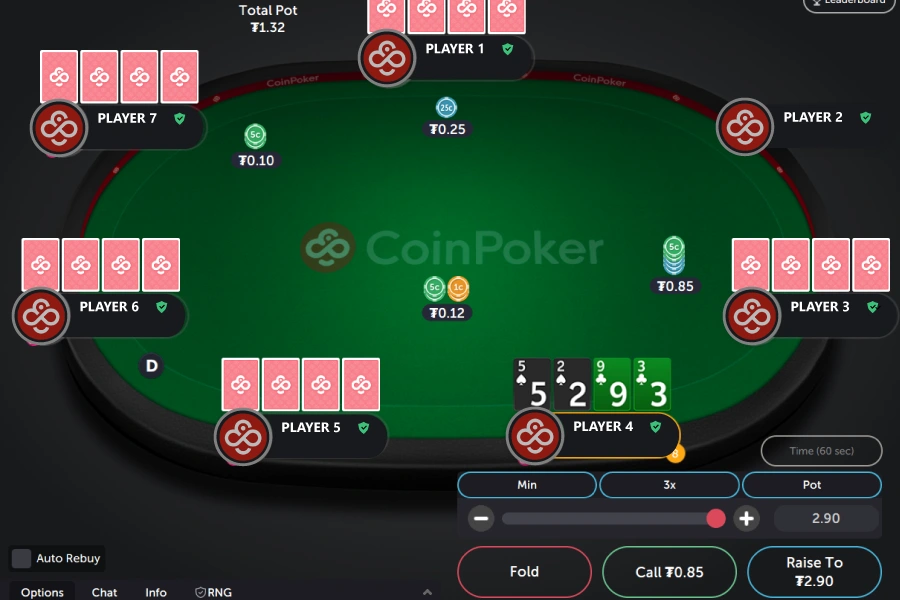
For example, if you are playing in a $0.10/$0.25 game (as shown above):
- A player raises to $0.85 preflop
- The pot size was $0.35 (the $0.10 small blind and $0.25 big blind)
- Multiply the bet by 3 ($0.85×3=$2.55)
- Add the money that was in the pot ($0.35)
- The total is $2.90, meaning your maximum allowed bet size is $2.90
This means a pot-sized bet would be $2.90 in this scenario.
In a postflop scenario, the same calculation applies. For example, if there is $30 in the pot, and a player bets $20, the pot size is $30 (the pot) + $60 (three times the outstanding bet) = $90.
You can continue applying this formula in all situations, and you will never get the pot size wrong again.
How to Make Hand Combinations in PLO
While the poker hand rankings in PLO are the same as those in NLH, there is one significant difference in how hand combinations are made.
In PLO, you must use precisely two hole cards and exactly three community cards to make a five-card hand. This is in contrast to NLH, where you can use any number of hole cards and community cards to make your hand.
For example, if you hold AsAdAc9h on a flop of Ah8c4d, you don’t have quad Aces, but only a set of Aces. Since only two hole cards may be used to make your five-card hand, you can only use two of the Aces from your hole cards to make a poker hand.
As another example, the player in the image below does not have a flush, despite seeing five spades (two on the table and three in their hand).
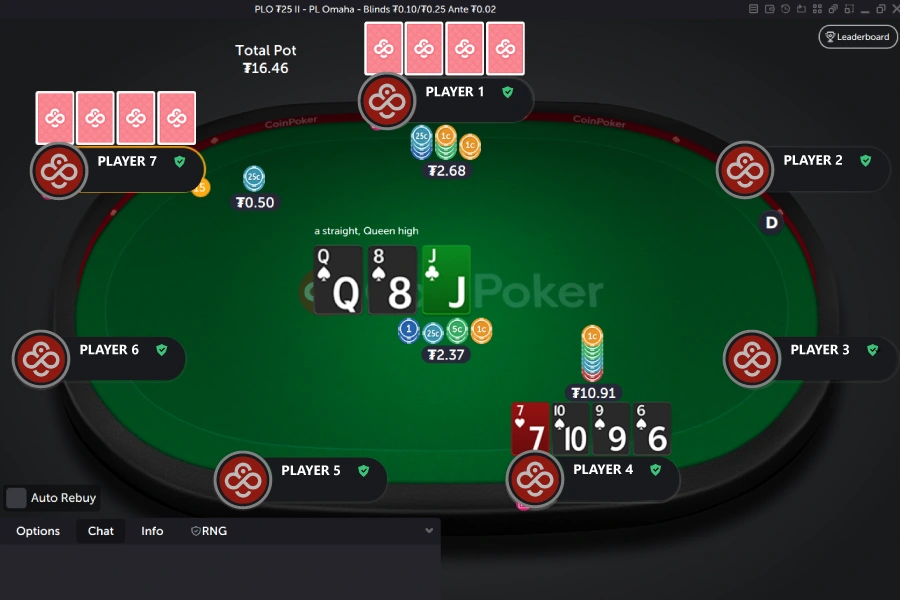
Pot Limit Omaha (PLO) Hand Rankings
The poker hand rankings in PLO are identical to those in Texas Hold’em. If you are already familiar with how poker hands work in NLH, you will also know which hand beats which in PLO. Just keep in mind that the way hands are made in PLO is significantly different from that in NLH.
Here is a look at all the possible poker hand rankings in PLO:
| Poker Hand | Hole Cards | Community Cards |
| Royal Flush | Ad Kd Kc 7c | Qd Jd Td 6s 2c |
| Straight Flush | 9h 8h 6c 4d | 7h 6h 5h Jd 2s |
| Four of a Kind (Quads) | Qs Qc Jh Jd | Qh Qd 8s 5c 7d |
| Full House | Th Ts 8d 5c | Td 7h 7c 4d 2h |
| Flush | Kh Jh 9d 7d | Ah 9h 7c 4s 3h |
| Straight | Jh Td 7h 4c | As 9c 8s 7c 4h |
| Three of a Kind | As Ad 9s 6d | Ah Th 7c 5d 4c |
| Two Pair | Kh Jh 8s 7s | Ah Kd Js 9h 5c |
| One Pair | Ah Ts 9s 7c | Ad Kh Qd 8s 5d |
| High Card | Kh Qd 9s 6c | As Td 8c 4s 2h |
How to Play PLO: Step-by-Step Guide
It’s time to learn how to play PLO, one step at a time. We will guide you through a full hand of PLO, from start to finish, showcasing every decision point you may come across.
Each PLO hand follows this pattern, so once you have mastered it, you will be ready to play your first PLO game.
1. Choose to Call, Fold, or Raise
Your first decision in PLO comes preflop. You may choose to fold your hole cards if you don’t like them, call the value of the big blind, or raise to the size of the pot. If another player raises before you, you can still fold, call the raise size, or place another raise. The size of the pot limits all preflop raising.
Image: The player has Kh Th 5h Ad and needs to choose an action
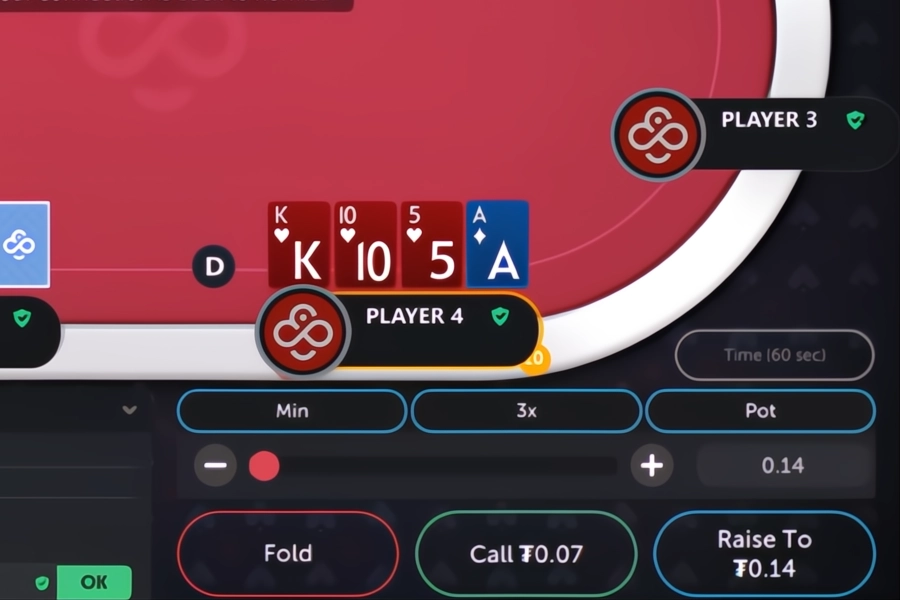
2. See the Flop
The dealer now deals the flop, made up of three community cards. If you haven’t folded your cards preflop, you will get another chance to act on your cards after the flop is dealt. As soon as the flop is dealt, you will have enough community cards at your disposal to build full poker hands.
Image: The flop is Ts 3c Ah, giving the player two pair with Tens and Aces
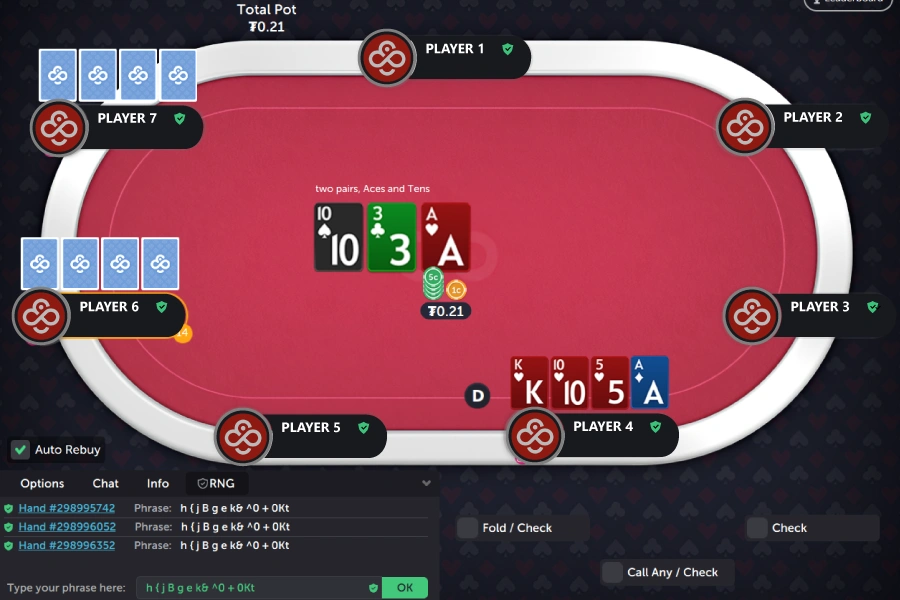
3. Choose an Action
Once the flop is dealt, remaining players are given a chance to act again, starting with the small blind. This time around, you may check your option (pass the action to the next player) or place a bet up to the size of the pot. If another player bets in front of you, you will be able to call or raise the bet, or fold your cards; however, the check option will be unavailable.
Image: The player decides what to do when another player bets $0.07 into a pot of $0.21
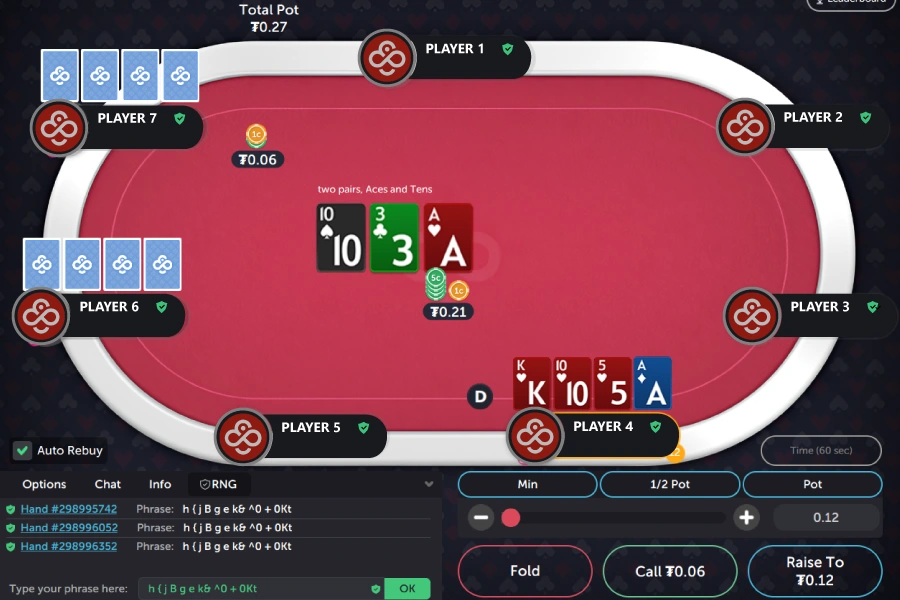
4. Repeat for Turn & River Rounds
The dealer deals the two remaining community cards over two streets (turn and river). After each of these is dealt, the remaining players will have a chance to act on their hands. The same options are available as the ones we described for flop action. Players take turns acting on their hands, starting with the small blind and ending with the dealer button.
Image: The player reaches the river with two pair – Aces and Tens
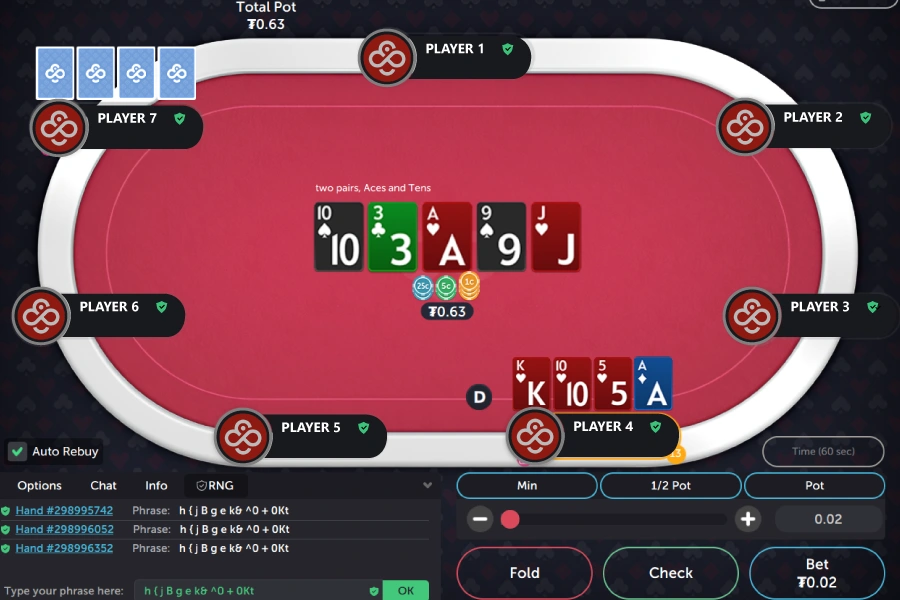
5. Show Cards at Showdown
Once all river betting is completed, players are asked to turn over their hole cards for a showdown. At showdown, players should turn over their cards starting from the small blind if no river betting occurred. If there was betting on the river, the player who took the last aggressive action should turn their cards over first.
Image: The player wins the pot against the other player, who shows a weaker two pair
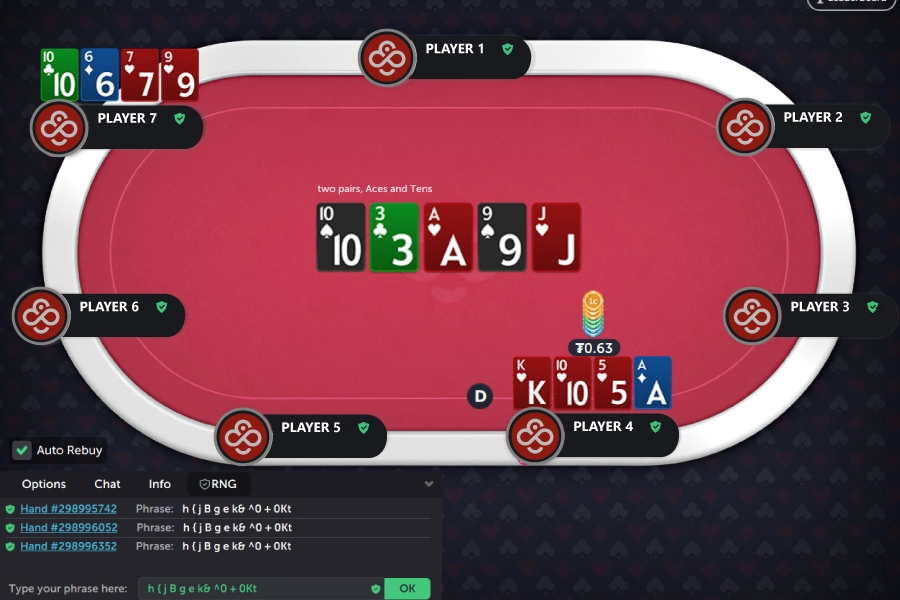
6. Decide a Winner & Start a New Round
The dealer compares the players’ hole cards and determines the winner in accordance with the hand rankings. It is much more common for the dealer to make a mistake comparing hands in PLO than in NLH, so make sure to stay vigilant and announce your hand verbally whenever possible. Once the pot is awarded to the winner, the next hand can start.
PLO Odds: Learn Important Drawing Odds for Pot Limit Omaha
PLO is a “game of draws,” as drawing hands have significant value and are often played very aggressively.
With more hole cards at your disposal, you are much more likely to flop draws, and massive straight draws called “wraps” are possible. Here is a look at the poker odds of some of the most common draws you may end up having in a PLO hand and what your chances of improving by the river are:
| Draw Type | Number of Outs | Odds |
| Six Card Wrap | 20 | 68% |
| Five Card Wrap | 17 | 60% |
| Open-Ended Straight Flush Draw | 15 | 54% |
| Gutshot Straight Flush Draw | 13 | 48% |
| Flush Draw | 9 | 35% |
| Full House with Three Pair | 6 | 24% |
| Open-Ended Straight Draw | 8 | 31.5% |
| Gutshot Straight Draw | 4 | 16.5% |
| Full House with Two Pair | 4 | 16.5% |
| Quads with a Set | 1 | 4.3% |
PLO Strategy for Beginners: Tips to Raise Your Skill Level
It’s time to get into some basic PLO strategy. These simple tips will teach you how to get around a PLO poker table and hold your own against more experienced competition. Keep in mind that these are only the most basic tips, with a more comprehensive strategy found in our detailed PLO strategy guide.
Calculating your outs correctly is vital in every poker game, but even more so in PLO. Since draws are such a big part of the game, you should always be aware of exactly how many cards may get dealt to improve your hand. Also, remember to differentiate between outs that turn your hand into the nuts, and those that will enhance it into a better, but not the best possible hand. The more outs you have, the more aggressively you can approach the hand.
Bluffing is a big part of Pot Limit Omaha, but it is more intricate than in NLH. While you may be able to bluff with any hand in NLH if you believe your opponent is weak, you will want to be more careful in PLO. In most cases, you should avoid bluffing without equity, and only turn hands into bluffs when you have a significant number of outs. Bluffing with “nothing” is inadvisable in PLO, as your opponents are much more likely to have a big hand.
If you are transitioning from Texas Hold’em, you may be tempted to value bet hands like top pair or weak two pair on the river. These types of hands have far less value in PLO and are typically hard to get much value with, as players are unlikely to call with worse hands. Apply a stricter criterion when considering which hands to value bet in PLO, and only bet when it’s likely a weaker hand will look you up.
PLO Variants: Different Styles of Omaha Poker to Try
While PLO is one of the most exciting poker games available at CoinPoker, it’s not the only one. You will find several other variants on our platform, each with its own unique twist on the game of poker:
- Texas Hold’em Poker: NLH is the world’s most popular poker game and the most widespread poker variant at CoinPoker. Play with two hole cards and no limit betting, and join thousands of poker players at the tables.
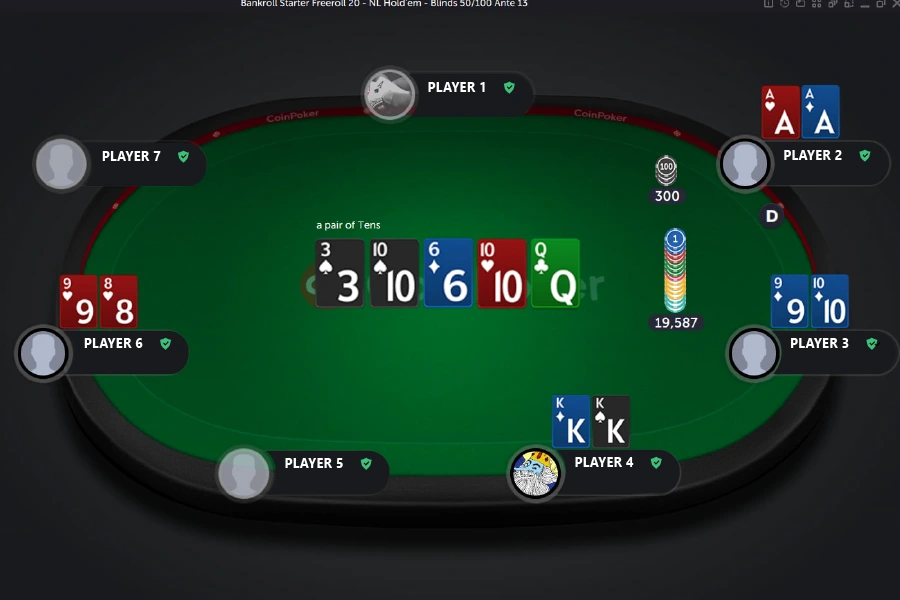
- Five Card PLO: PLO5 is an even more action-packed version of PLO, as another hole card is added to the mix. The other rules remain the same, but the extra hole card makes every hand even more exciting.
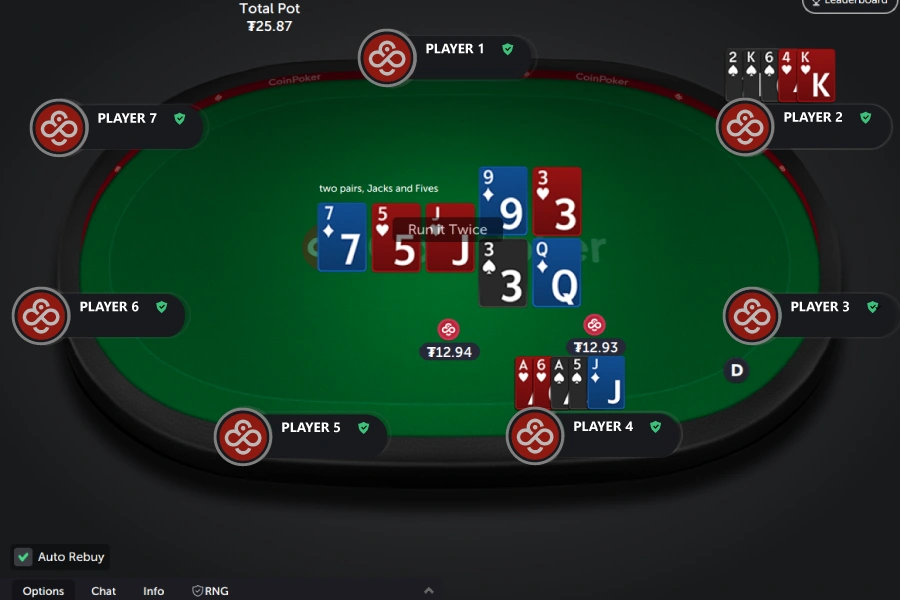
- Video Poker: If you want to play a simpler version of poker, video poker is the ideal game for you. Our video poker machines require only a simple strategy, as other players are not involved.
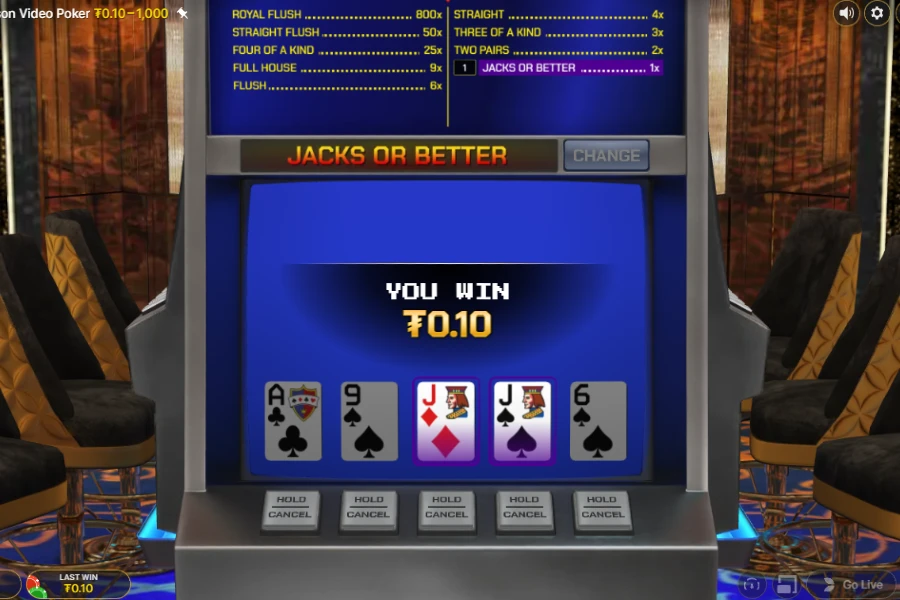
Learn the History of Pot-Limit Omaha
Pot Limit Omaha dates back to the 1980s. While it’s unclear who invented the game, it was first popularized by the Golden Nugget Casino in Las Vegas, with Robert Turner introducing the game to Bill Boyd, the manager of the Golden Nugget card room. In the early years, the game was often called “Nugget Hold’em.”
Omaha made its first appearance on the big stage at the 1983 World Series of Poker (WSOP), which solidified it as a major poker variant. Over the 1980s and 90s, PLO spread to Europe and grew in popularity in card rooms across London, Helsinki, and Vienna.
In the years of the Poker Boom, PLO gained global popularity. It was introduced at major online poker sites and quickly became the game of choice for many seasoned professionals. Today, PLO is the second most popular poker variant, trailing only behind Texas Hold’em Poker.
We’ve Got the Best Online PLO Games – Try Them Today
Are you ready to start playing PLO yourself? Join CoinPoker today and play the game with hundreds of players at our PLO tables, with stakes ranging from just $0.01/$0.02 to as high as $1,000/$2,000. Apply your newly found PLO knowledge at the low stakes, master the game, and build your way up to our high-stakes tables, where the best players in the world await.
Related Articles
FAQs
Players are dealt four hole cards and must use two of them in combination with three community cards to make their hand. In addition, all betting is limited by the pot size
Pot limit betting means that the maximum amount you can bet at any time is equal to the total size of the pot.
In every hand of PLO, each player is dealt four hole cards, while five community cards are dealt for all players to use.
The best starting hand in PLO is AAKK, double-suited.
You can join CoinPoker and start playing real money PLO from anywhere in the world, with stakes starting as low as $0.01/$0.02.
Explore More
Announcements
Read recent announcements from CoinPoker about new games, ambassadors, and changes to our platform.
8 PostsGuides
The go-to resource for mastering poker with expert tips and strategies. Whether you're a beginner or a pro, our guides will elevate your skill level.
60 PostsNews
Find the latest poker news, plus our latest CoinPoker Weekly and Monthly Newsletters. Updates about games, promotions and other exciting crypto news.
91 PostsPromotions
Find the latest coinpoker promotions here. Explore the crypto poker world with the best poker promotions available.
1 Post



